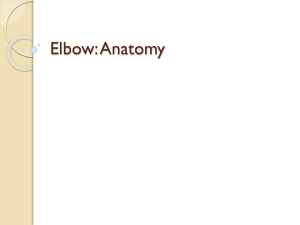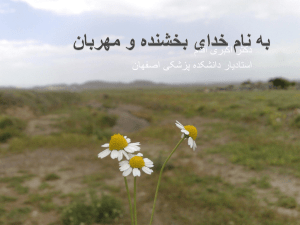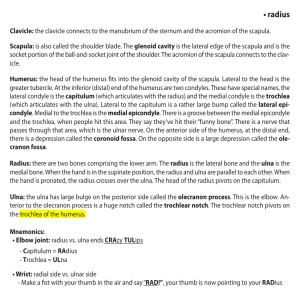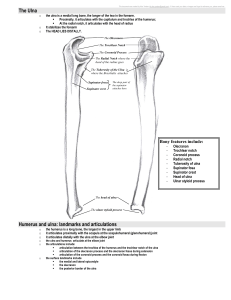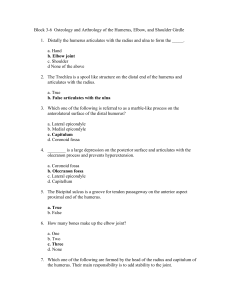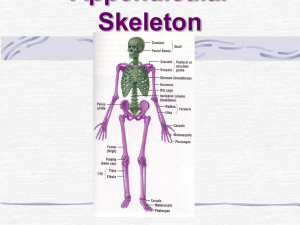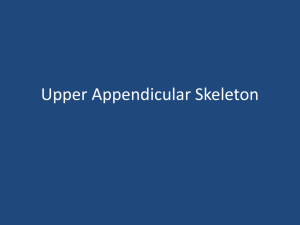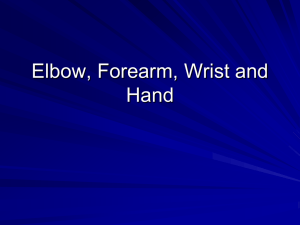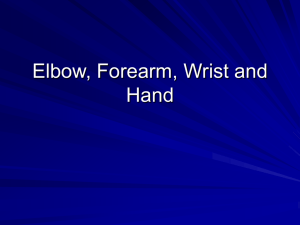Muscles of the Elbow
advertisement
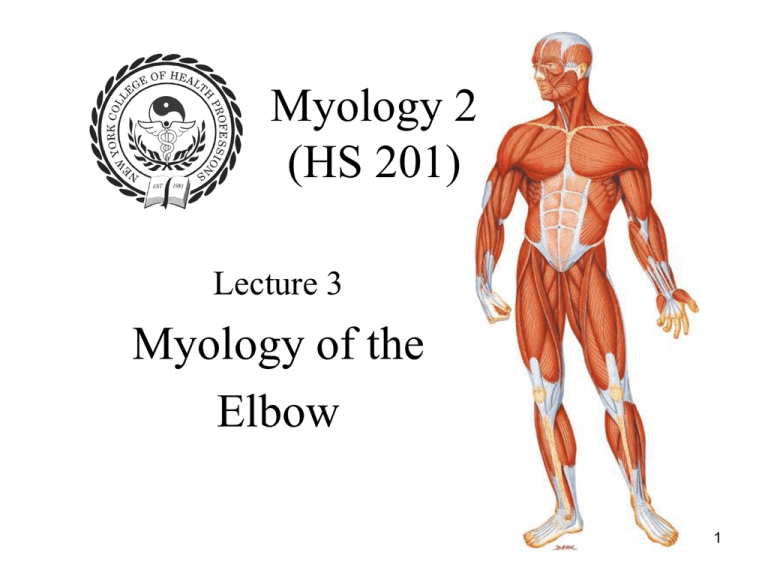
Myology 2 (HS 201) Lecture 3 Myology of the Elbow 1 Distal Humerus • Anatomy: – Capitulum: rounded knob that articulates with the head of the radius – Radial fossa: anterior depression that receives the head of the radius when the forearm is flexed – Trochlea: spool-shaped surface that articulates with the ulna – Coronoid fossa: anterior depression that receives the coronoid process when the forearm is flexed – Olecranon fossa: posterior depression receiving the olecranon process of the ulna when the forearm is extended – Medial and lateral epicondyles: projections on either side for attachment of many forearm muscles. 2 Anatomical Review Distal Humerus 3 Ulna • Ulna located on the medial forearm • Longer than the radius • Anatomy: – Olecranon process: large process on the proximal end of the elbow – Coronoid process: an anterior projection of bone that with the olecranon receives the trochlea of the humerus – Ulnar tuberosity: ridge of bone inferior to the coronoid process – Trochlear (semilunar) notch: large curved area between the olecranon and the coronoid process – Radial notch: depression on the lateral humerus that receives the head of the radius – Head: rounded distal end of the ulna – Styloid process: small projection distal to the head of the ulna 4 Radius • Located on the lateral side of the forearm • Anatomy: – Head: disc shaped proximal end of the radius which articulates with the capitulum of the humerus. – Neck: constricted area distal to the head – Radial tuberosity: roughened area on the proximal medial shaft for attachment of the biceps brachii muscle – Shaft: widens distally to articulate with the scaphoid and lunate bones of the wrist – Styloid process: small bony projection at the distal end of the radius – Ulnar notch: depression on the medial side of the radius for articulation with the distal end of the ulna 5 Anatomical Review Proximal Ulna and Radius 6 Articular Anatomy of the Elbow • Elbow is a hinge joint formed by the articulation of the distal humerus and proximal radius and ulna • Made up of three joints: – Humeroradial: joint between the capitulum and the head of the radius – Humeroulnar: joint between the trochlea and the trochlear notch of the ulna – Radioulnar: joint between the head of the radius and the radial notch of the ulna 7 Soft Tissue of the Elbow Interosseous Membrane: A broad, flat fibrous connective tissue that joins the shafts of the radius and ulna Articular Capsule: Extends from distal humerus to proximal radius and ulna (enveloping the entire joint) Ulnar Collateral Ligament: Thick triangular ligament extending from medial epicondyle of the humerus to the coronoid process and olecranon of the ulna 8 Soft Tissue of the Elbow Radial Collateral Ligament: Strong triangular ligament extending from the lateral epicondyle of the humerus to the annular ligament of the radius and radial notch of the ulna Radial Annular Ligament: Ligament encircling the head/neck of the radius and radial notch of the ulna Olecranon Bursa: Fluid filled sac lining the olecranon process. Lubricates the joint 9 Elbow Ranges of Motion Each student should be able to describe and demonstrate the following movements: 1. 2. 3. 4. Elbow flexion Elbow extension Pronation Supination 10 Palpation of the elbow Olecranon Process: Sitting; Shake hands with your partner and palpate large prominence of the elbow. Passively flex and extend the elbow observe how the olecranon moves. Olecranon Fossa: Sitting; Locate the olecranon process again. Roll your finger proximally around the top of the process, pressing through the triceps tendon and into the fossa. Humeral epicondyles: Sitting; Again locate the olecranon process. Slide your fingers medially and laterally off the olecranon feeling the prominences. Note that the medial is larger. Supracondylar ridges: Sitting; Locate the epicondyles, slide your fingers proximally toward the shoulder feeling the medial and lateral supracondylar ridges. Roll your fingers back and forth to feel the edges. Shaft of the ulna: Sitting; Again, locate the olecranon process and then slide your hand distally along the shaft of the ulna (remember the ulna is medial). Follow it along the length of the forearm. Ulnar Head: Sitting; Slide your finger along the shaft of the ulna. Just proximal to the wrist the shaft will bulge to become the ulnar head. Ulnar styloid process: Sitting; Find the posterior aspect of the ulnar head then slide distally off the head and palpate the ulnar styloid process. 11 Palpation of the elbow (cont.) Radial Head: Sitting; Locate the lateral epicondyle and slide distally. Notice a small depression between the humerus and radius. The distal side of the depression is the radial head. Have your partner pronate and supinate the forearm feeling the radial rotate. Radial Shaft: Sitting; Supinate and flex your partner’s elbow, find the radial head again and slide your fingers distally along the radial shaft. Radial styloid process: Sitting: Find the distal radial shaft to the end feeling the lateral side of the radius to the tip of the styloid process. 12 Muscles that move the Elbow Biceps Brachii Brachialis Brachioradialis Triceps Brachii Anconeus Pronator Teres Pronator Quadratus Supinator 13 Biceps Brachii O: Long Head: Supraglenoid tubercle of the scapula Short Head: Corocoid process of the scapula I: Radial tuberosity A: Shoulder: Flexes the arm Elbow: Flexes the elbow and assists in supination when power is required. **Note: the long head can cause abduction of the arm, while the short head can cause adduction N: Musculocutaneous nerve 14 Brachialis O: Anterior aspect of the humeral shaft I: Coronoid process of the ulna A: Flexion of the forearm N: Musculocutaneous nerve Brachialis is located deep to the biceps brachii 15 Brachioradialis O: Lateral supracondylar ridge of the humerus I: Styloid process of the radius A: Flexion of the elbow in the neutral position (shaking hands). Also assists in supination and pronation of the forearm. N: Radial nerve 16 Triceps Brachii O: Long Head: Infraglenoid tubercle of the scapula Lateral Head: Posterior aspect of the shaft of the humerus (proximal ½) Medial Head: Posterior aspect of the shaft of the humerus (distal ½) I: Olecranon Process of the Ulna A: Shoulder: Extends the arm Elbow: Extends the elbow ** Note: the long head can cause adduction of the arm N: Radial nerve 17 Anconeus O: Lateral epicondyle of the humerus I: Olecranon process of the ulna A: Extension of the elbow (weak) N: Radial nerve 18 Pronator Teres O: Humeral Head: medial epicondyle (via common flexor tendon) of the humerus Ulnar Head: Coronoid process of the ulna I: Lateral aspect of the shaft of the radius A: Pronates the forearm and flexes the elbow. Assists in flexion of the elbow N: Median nerve 19 Pronator Quadratus O: Distal ¼ of the Ulna I: Distal ¼ of the Radius A: Pronation of the forearm N: Median nerve 20 Supinator O: Lateral epicondyle of the humerus and proximal ulna I: Proximal anterior radius A: Supination of the forearm (for slow non-resisted supination the supinator is sufficient. When speed or resistance is required, the biceps brachii is recruited. N: Radial Nerve 21
